TEMAOS Data Structure and Algorithm for Inventory System: Report
VerifiedAdded on 2022/11/28
|10
|1948
|307
Report
AI Summary
This report analyzes the design of an inventory system for a company managing household goods and food items. It details key variables, including product type, price, and supplier information, as well as key variables like product id, purchase id and supplier id. The report outlines the importance of a key variable, its role in data manipulation, and the range of products. The report then defines the operations by the inventory which include safety stock levels, order levels, and economic order quantity, as well as FIFO and ABC analysis principles for inventory management. The report suggests using a quick sorting algorithm with O(n log n) complexity and a binary search algorithm for efficient data handling. The report also addresses system scalability, discussing how the system can adapt to increased data volume after a company merge, ensuring the algorithms and hardware can handle the increased load. The report concludes that the proposed system provides an effective solution for data management and inventory control, capable of scaling to meet future business needs.

rams rama
TEMAOS
DATA STRUCTURE AND ALGORITHM
TEMAOS
DATA STRUCTURE AND ALGORITHM
Paraphrase This Document
Need a fresh take? Get an instant paraphrase of this document with our AI Paraphraser
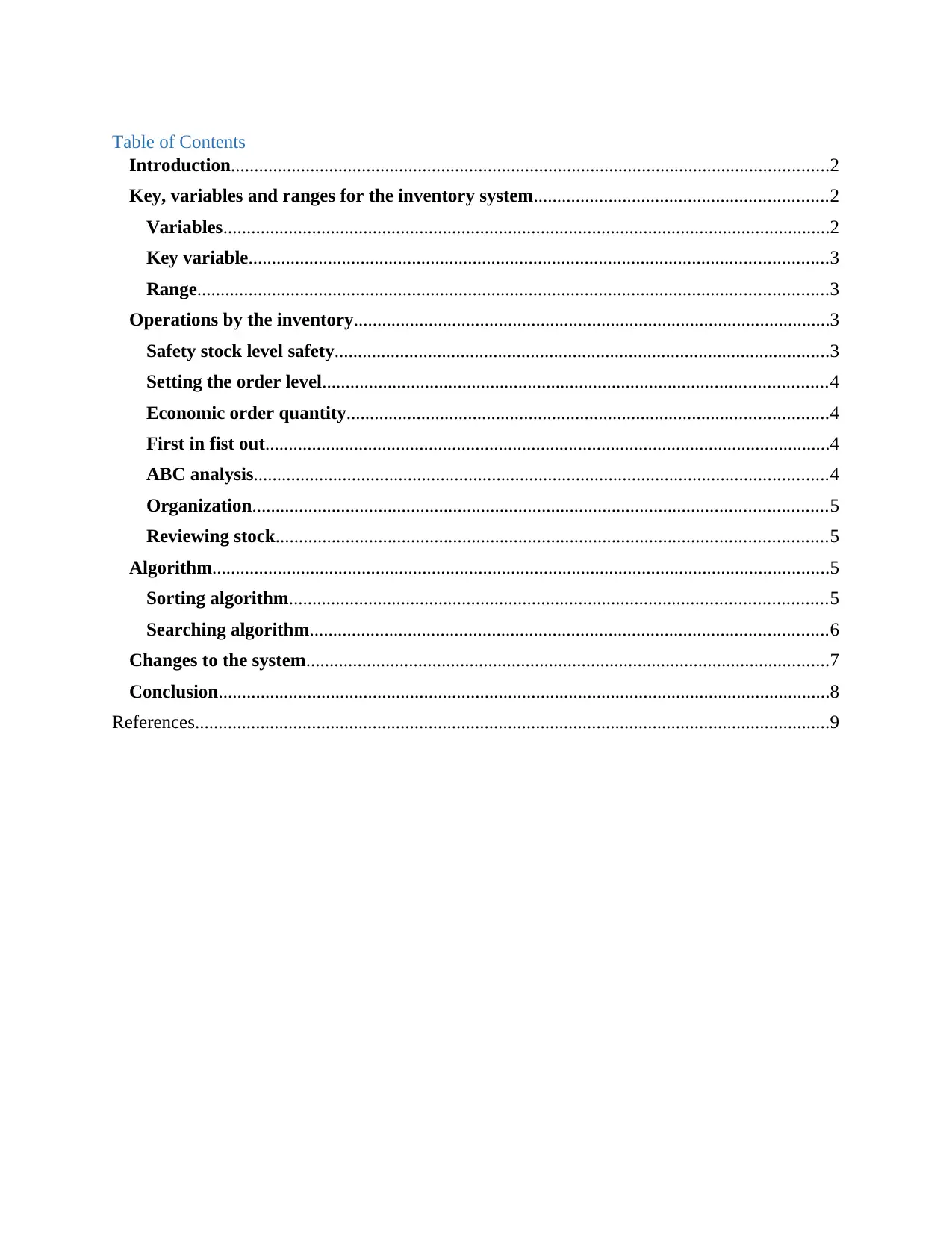
Table of Contents
Introduction................................................................................................................................2
Key, variables and ranges for the inventory system...............................................................2
Variables..................................................................................................................................2
Key variable............................................................................................................................3
Range.......................................................................................................................................3
Operations by the inventory......................................................................................................3
Safety stock level safety..........................................................................................................3
Setting the order level............................................................................................................4
Economic order quantity.......................................................................................................4
First in fist out.........................................................................................................................4
ABC analysis...........................................................................................................................4
Organization...........................................................................................................................5
Reviewing stock......................................................................................................................5
Algorithm....................................................................................................................................5
Sorting algorithm...................................................................................................................5
Searching algorithm...............................................................................................................6
Changes to the system................................................................................................................7
Conclusion...................................................................................................................................8
References........................................................................................................................................9
Introduction................................................................................................................................2
Key, variables and ranges for the inventory system...............................................................2
Variables..................................................................................................................................2
Key variable............................................................................................................................3
Range.......................................................................................................................................3
Operations by the inventory......................................................................................................3
Safety stock level safety..........................................................................................................3
Setting the order level............................................................................................................4
Economic order quantity.......................................................................................................4
First in fist out.........................................................................................................................4
ABC analysis...........................................................................................................................4
Organization...........................................................................................................................5
Reviewing stock......................................................................................................................5
Algorithm....................................................................................................................................5
Sorting algorithm...................................................................................................................5
Searching algorithm...............................................................................................................6
Changes to the system................................................................................................................7
Conclusion...................................................................................................................................8
References........................................................................................................................................9
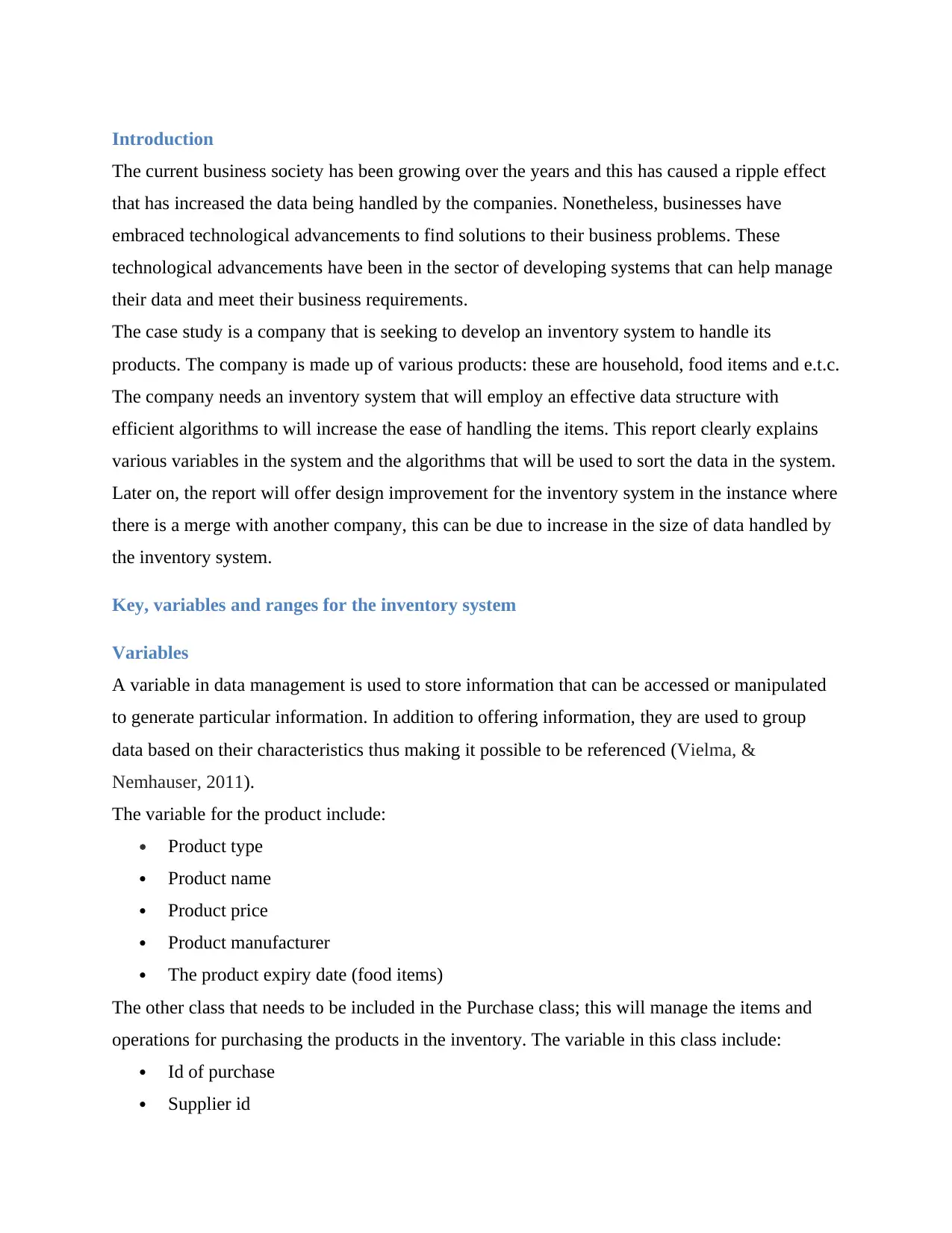
Introduction
The current business society has been growing over the years and this has caused a ripple effect
that has increased the data being handled by the companies. Nonetheless, businesses have
embraced technological advancements to find solutions to their business problems. These
technological advancements have been in the sector of developing systems that can help manage
their data and meet their business requirements.
The case study is a company that is seeking to develop an inventory system to handle its
products. The company is made up of various products: these are household, food items and e.t.c.
The company needs an inventory system that will employ an effective data structure with
efficient algorithms to will increase the ease of handling the items. This report clearly explains
various variables in the system and the algorithms that will be used to sort the data in the system.
Later on, the report will offer design improvement for the inventory system in the instance where
there is a merge with another company, this can be due to increase in the size of data handled by
the inventory system.
Key, variables and ranges for the inventory system
Variables
A variable in data management is used to store information that can be accessed or manipulated
to generate particular information. In addition to offering information, they are used to group
data based on their characteristics thus making it possible to be referenced (Vielma, &
Nemhauser, 2011).
The variable for the product include:
Product type
Product name
Product price
Product manufacturer
The product expiry date (food items)
The other class that needs to be included in the Purchase class; this will manage the items and
operations for purchasing the products in the inventory. The variable in this class include:
Id of purchase
Supplier id
The current business society has been growing over the years and this has caused a ripple effect
that has increased the data being handled by the companies. Nonetheless, businesses have
embraced technological advancements to find solutions to their business problems. These
technological advancements have been in the sector of developing systems that can help manage
their data and meet their business requirements.
The case study is a company that is seeking to develop an inventory system to handle its
products. The company is made up of various products: these are household, food items and e.t.c.
The company needs an inventory system that will employ an effective data structure with
efficient algorithms to will increase the ease of handling the items. This report clearly explains
various variables in the system and the algorithms that will be used to sort the data in the system.
Later on, the report will offer design improvement for the inventory system in the instance where
there is a merge with another company, this can be due to increase in the size of data handled by
the inventory system.
Key, variables and ranges for the inventory system
Variables
A variable in data management is used to store information that can be accessed or manipulated
to generate particular information. In addition to offering information, they are used to group
data based on their characteristics thus making it possible to be referenced (Vielma, &
Nemhauser, 2011).
The variable for the product include:
Product type
Product name
Product price
Product manufacturer
The product expiry date (food items)
The other class that needs to be included in the Purchase class; this will manage the items and
operations for purchasing the products in the inventory. The variable in this class include:
Id of purchase
Supplier id
⊘ This is a preview!⊘
Do you want full access?
Subscribe today to unlock all pages.

Trusted by 1+ million students worldwide
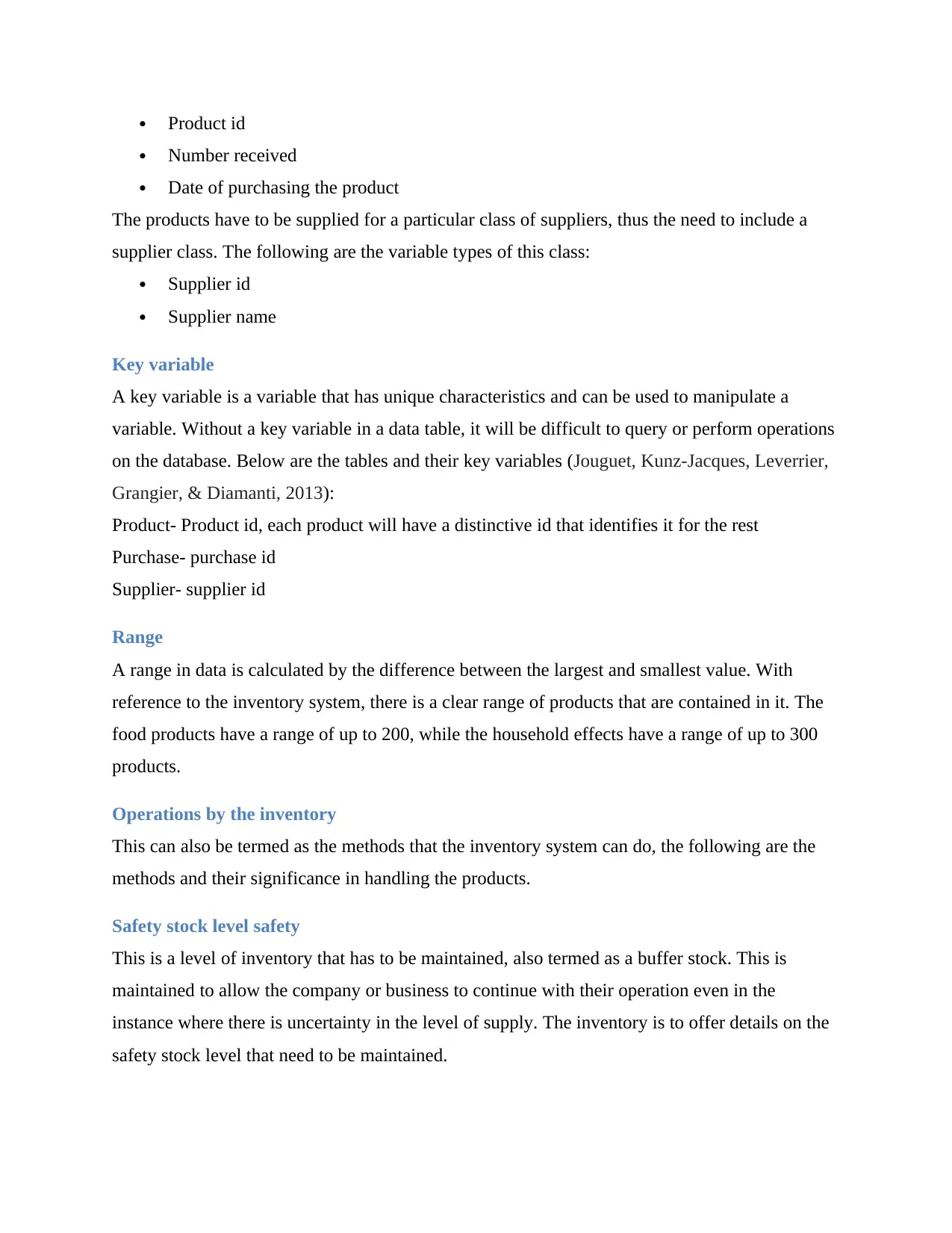
Product id
Number received
Date of purchasing the product
The products have to be supplied for a particular class of suppliers, thus the need to include a
supplier class. The following are the variable types of this class:
Supplier id
Supplier name
Key variable
A key variable is a variable that has unique characteristics and can be used to manipulate a
variable. Without a key variable in a data table, it will be difficult to query or perform operations
on the database. Below are the tables and their key variables (Jouguet, Kunz-Jacques, Leverrier,
Grangier, & Diamanti, 2013):
Product- Product id, each product will have a distinctive id that identifies it for the rest
Purchase- purchase id
Supplier- supplier id
Range
A range in data is calculated by the difference between the largest and smallest value. With
reference to the inventory system, there is a clear range of products that are contained in it. The
food products have a range of up to 200, while the household effects have a range of up to 300
products.
Operations by the inventory
This can also be termed as the methods that the inventory system can do, the following are the
methods and their significance in handling the products.
Safety stock level safety
This is a level of inventory that has to be maintained, also termed as a buffer stock. This is
maintained to allow the company or business to continue with their operation even in the
instance where there is uncertainty in the level of supply. The inventory is to offer details on the
safety stock level that need to be maintained.
Number received
Date of purchasing the product
The products have to be supplied for a particular class of suppliers, thus the need to include a
supplier class. The following are the variable types of this class:
Supplier id
Supplier name
Key variable
A key variable is a variable that has unique characteristics and can be used to manipulate a
variable. Without a key variable in a data table, it will be difficult to query or perform operations
on the database. Below are the tables and their key variables (Jouguet, Kunz-Jacques, Leverrier,
Grangier, & Diamanti, 2013):
Product- Product id, each product will have a distinctive id that identifies it for the rest
Purchase- purchase id
Supplier- supplier id
Range
A range in data is calculated by the difference between the largest and smallest value. With
reference to the inventory system, there is a clear range of products that are contained in it. The
food products have a range of up to 200, while the household effects have a range of up to 300
products.
Operations by the inventory
This can also be termed as the methods that the inventory system can do, the following are the
methods and their significance in handling the products.
Safety stock level safety
This is a level of inventory that has to be maintained, also termed as a buffer stock. This is
maintained to allow the company or business to continue with their operation even in the
instance where there is uncertainty in the level of supply. The inventory is to offer details on the
safety stock level that need to be maintained.
Paraphrase This Document
Need a fresh take? Get an instant paraphrase of this document with our AI Paraphraser
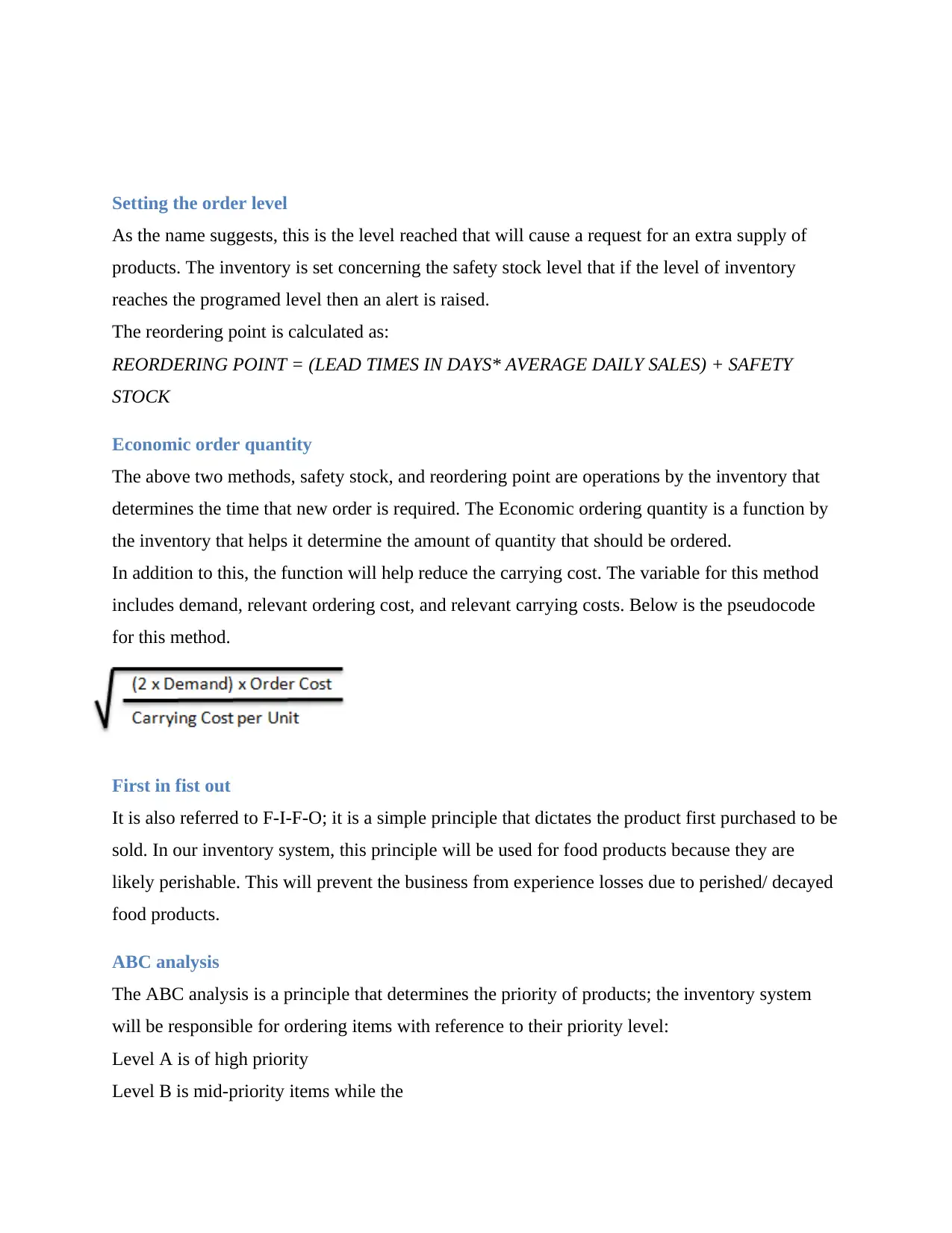
Setting the order level
As the name suggests, this is the level reached that will cause a request for an extra supply of
products. The inventory is set concerning the safety stock level that if the level of inventory
reaches the programed level then an alert is raised.
The reordering point is calculated as:
REORDERING POINT = (LEAD TIMES IN DAYS* AVERAGE DAILY SALES) + SAFETY
STOCK
Economic order quantity
The above two methods, safety stock, and reordering point are operations by the inventory that
determines the time that new order is required. The Economic ordering quantity is a function by
the inventory that helps it determine the amount of quantity that should be ordered.
In addition to this, the function will help reduce the carrying cost. The variable for this method
includes demand, relevant ordering cost, and relevant carrying costs. Below is the pseudocode
for this method.
First in fist out
It is also referred to F-I-F-O; it is a simple principle that dictates the product first purchased to be
sold. In our inventory system, this principle will be used for food products because they are
likely perishable. This will prevent the business from experience losses due to perished/ decayed
food products.
ABC analysis
The ABC analysis is a principle that determines the priority of products; the inventory system
will be responsible for ordering items with reference to their priority level:
Level A is of high priority
Level B is mid-priority items while the
As the name suggests, this is the level reached that will cause a request for an extra supply of
products. The inventory is set concerning the safety stock level that if the level of inventory
reaches the programed level then an alert is raised.
The reordering point is calculated as:
REORDERING POINT = (LEAD TIMES IN DAYS* AVERAGE DAILY SALES) + SAFETY
STOCK
Economic order quantity
The above two methods, safety stock, and reordering point are operations by the inventory that
determines the time that new order is required. The Economic ordering quantity is a function by
the inventory that helps it determine the amount of quantity that should be ordered.
In addition to this, the function will help reduce the carrying cost. The variable for this method
includes demand, relevant ordering cost, and relevant carrying costs. Below is the pseudocode
for this method.
First in fist out
It is also referred to F-I-F-O; it is a simple principle that dictates the product first purchased to be
sold. In our inventory system, this principle will be used for food products because they are
likely perishable. This will prevent the business from experience losses due to perished/ decayed
food products.
ABC analysis
The ABC analysis is a principle that determines the priority of products; the inventory system
will be responsible for ordering items with reference to their priority level:
Level A is of high priority
Level B is mid-priority items while the
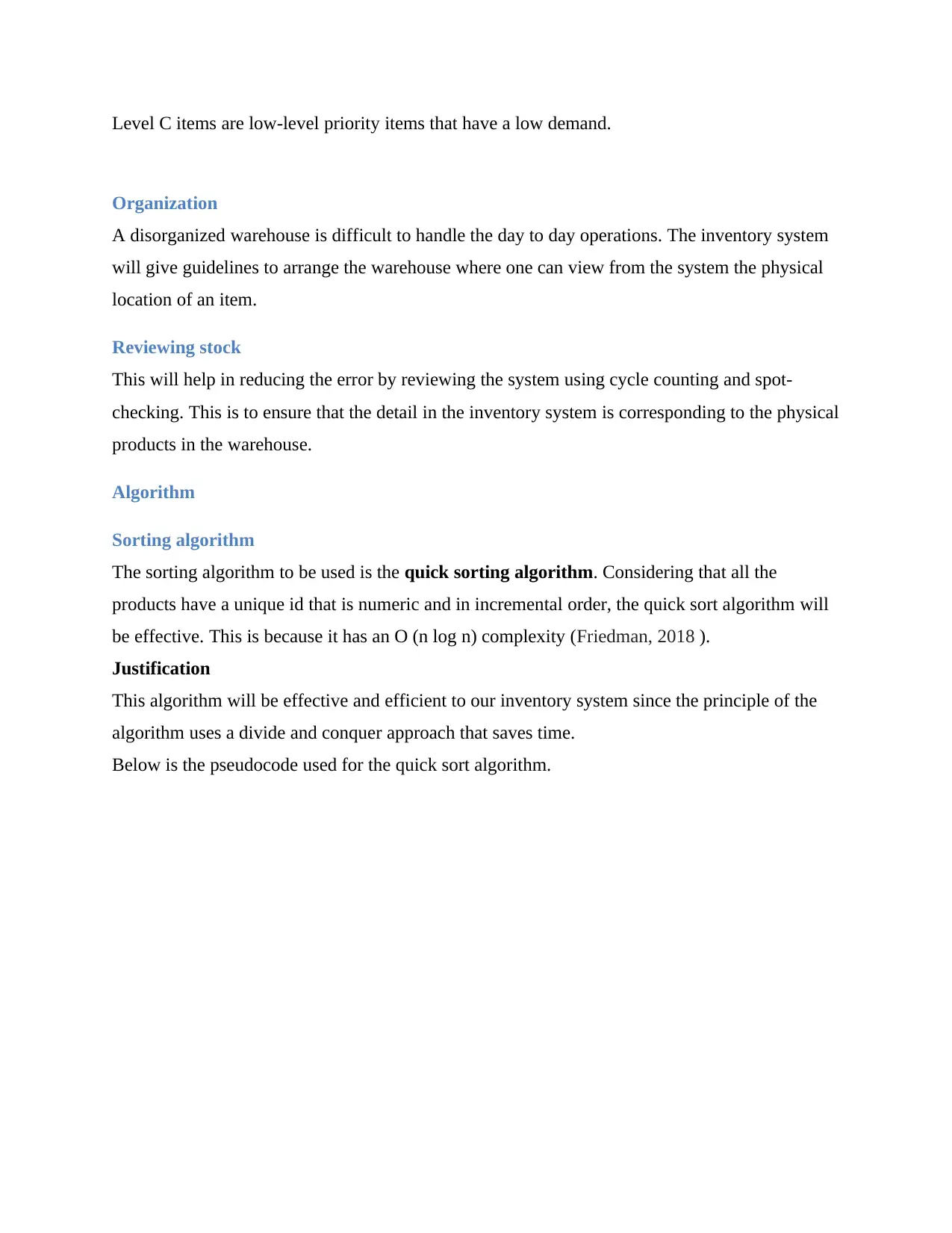
Level C items are low-level priority items that have a low demand.
Organization
A disorganized warehouse is difficult to handle the day to day operations. The inventory system
will give guidelines to arrange the warehouse where one can view from the system the physical
location of an item.
Reviewing stock
This will help in reducing the error by reviewing the system using cycle counting and spot-
checking. This is to ensure that the detail in the inventory system is corresponding to the physical
products in the warehouse.
Algorithm
Sorting algorithm
The sorting algorithm to be used is the quick sorting algorithm. Considering that all the
products have a unique id that is numeric and in incremental order, the quick sort algorithm will
be effective. This is because it has an O (n log n) complexity (Friedman, 2018 ).
Justification
This algorithm will be effective and efficient to our inventory system since the principle of the
algorithm uses a divide and conquer approach that saves time.
Below is the pseudocode used for the quick sort algorithm.
Organization
A disorganized warehouse is difficult to handle the day to day operations. The inventory system
will give guidelines to arrange the warehouse where one can view from the system the physical
location of an item.
Reviewing stock
This will help in reducing the error by reviewing the system using cycle counting and spot-
checking. This is to ensure that the detail in the inventory system is corresponding to the physical
products in the warehouse.
Algorithm
Sorting algorithm
The sorting algorithm to be used is the quick sorting algorithm. Considering that all the
products have a unique id that is numeric and in incremental order, the quick sort algorithm will
be effective. This is because it has an O (n log n) complexity (Friedman, 2018 ).
Justification
This algorithm will be effective and efficient to our inventory system since the principle of the
algorithm uses a divide and conquer approach that saves time.
Below is the pseudocode used for the quick sort algorithm.
⊘ This is a preview!⊘
Do you want full access?
Subscribe today to unlock all pages.

Trusted by 1+ million students worldwide
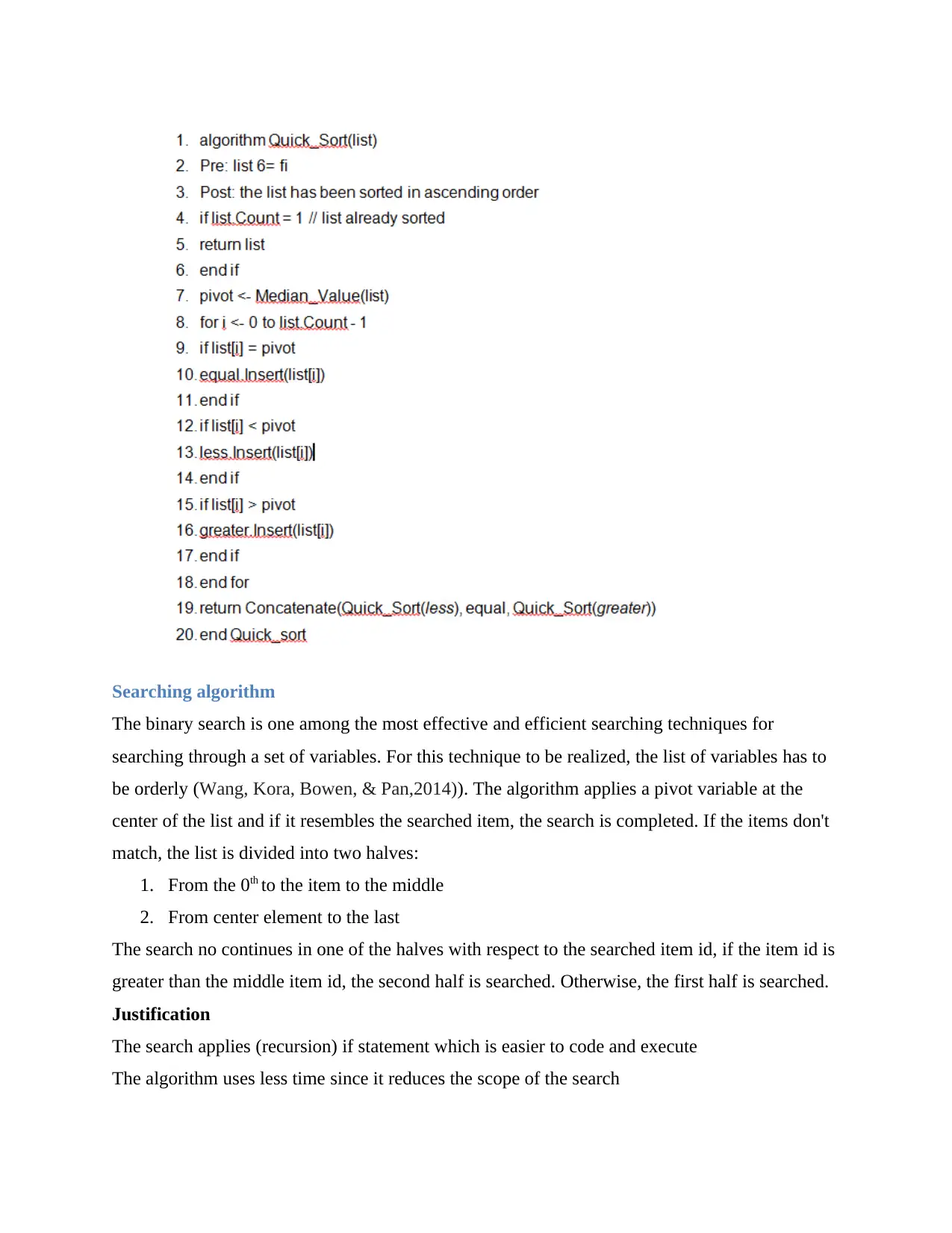
Searching algorithm
The binary search is one among the most effective and efficient searching techniques for
searching through a set of variables. For this technique to be realized, the list of variables has to
be orderly (Wang, Kora, Bowen, & Pan,2014)). The algorithm applies a pivot variable at the
center of the list and if it resembles the searched item, the search is completed. If the items don't
match, the list is divided into two halves:
1. From the 0th to the item to the middle
2. From center element to the last
The search no continues in one of the halves with respect to the searched item id, if the item id is
greater than the middle item id, the second half is searched. Otherwise, the first half is searched.
Justification
The search applies (recursion) if statement which is easier to code and execute
The algorithm uses less time since it reduces the scope of the search
The binary search is one among the most effective and efficient searching techniques for
searching through a set of variables. For this technique to be realized, the list of variables has to
be orderly (Wang, Kora, Bowen, & Pan,2014)). The algorithm applies a pivot variable at the
center of the list and if it resembles the searched item, the search is completed. If the items don't
match, the list is divided into two halves:
1. From the 0th to the item to the middle
2. From center element to the last
The search no continues in one of the halves with respect to the searched item id, if the item id is
greater than the middle item id, the second half is searched. Otherwise, the first half is searched.
Justification
The search applies (recursion) if statement which is easier to code and execute
The algorithm uses less time since it reduces the scope of the search
Paraphrase This Document
Need a fresh take? Get an instant paraphrase of this document with our AI Paraphraser
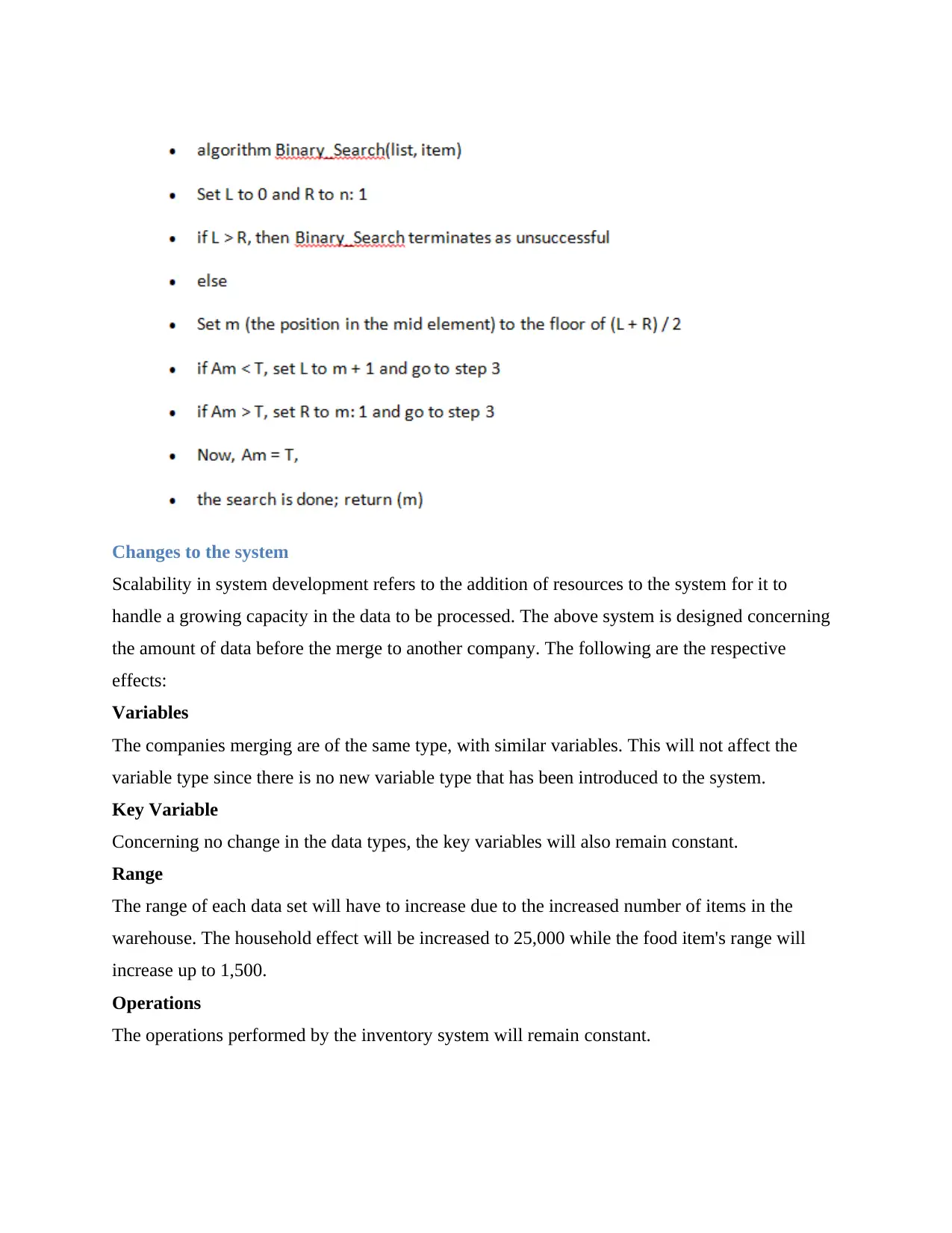
Changes to the system
Scalability in system development refers to the addition of resources to the system for it to
handle a growing capacity in the data to be processed. The above system is designed concerning
the amount of data before the merge to another company. The following are the respective
effects:
Variables
The companies merging are of the same type, with similar variables. This will not affect the
variable type since there is no new variable type that has been introduced to the system.
Key Variable
Concerning no change in the data types, the key variables will also remain constant.
Range
The range of each data set will have to increase due to the increased number of items in the
warehouse. The household effect will be increased to 25,000 while the food item's range will
increase up to 1,500.
Operations
The operations performed by the inventory system will remain constant.
Scalability in system development refers to the addition of resources to the system for it to
handle a growing capacity in the data to be processed. The above system is designed concerning
the amount of data before the merge to another company. The following are the respective
effects:
Variables
The companies merging are of the same type, with similar variables. This will not affect the
variable type since there is no new variable type that has been introduced to the system.
Key Variable
Concerning no change in the data types, the key variables will also remain constant.
Range
The range of each data set will have to increase due to the increased number of items in the
warehouse. The household effect will be increased to 25,000 while the food item's range will
increase up to 1,500.
Operations
The operations performed by the inventory system will remain constant.
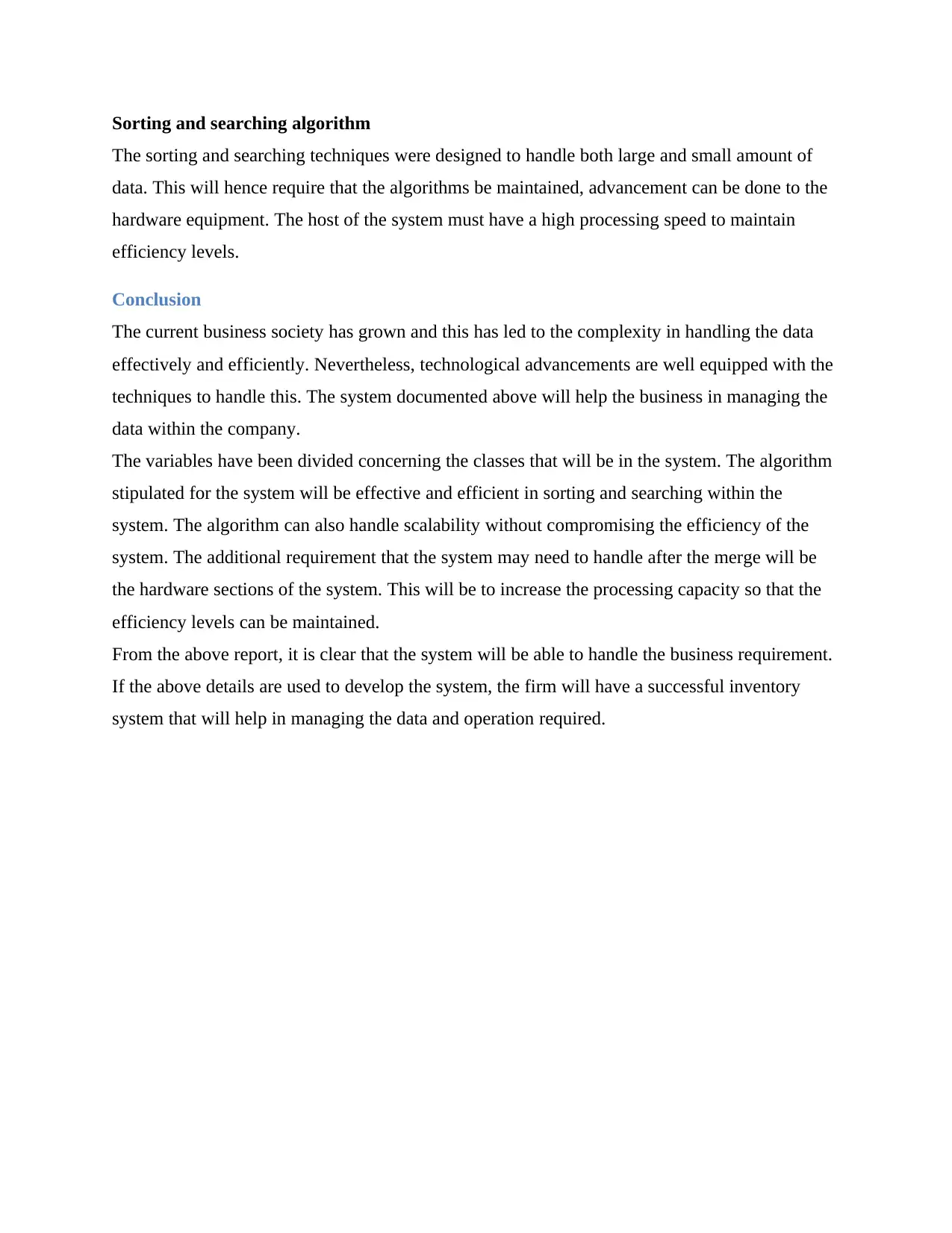
Sorting and searching algorithm
The sorting and searching techniques were designed to handle both large and small amount of
data. This will hence require that the algorithms be maintained, advancement can be done to the
hardware equipment. The host of the system must have a high processing speed to maintain
efficiency levels.
Conclusion
The current business society has grown and this has led to the complexity in handling the data
effectively and efficiently. Nevertheless, technological advancements are well equipped with the
techniques to handle this. The system documented above will help the business in managing the
data within the company.
The variables have been divided concerning the classes that will be in the system. The algorithm
stipulated for the system will be effective and efficient in sorting and searching within the
system. The algorithm can also handle scalability without compromising the efficiency of the
system. The additional requirement that the system may need to handle after the merge will be
the hardware sections of the system. This will be to increase the processing capacity so that the
efficiency levels can be maintained.
From the above report, it is clear that the system will be able to handle the business requirement.
If the above details are used to develop the system, the firm will have a successful inventory
system that will help in managing the data and operation required.
The sorting and searching techniques were designed to handle both large and small amount of
data. This will hence require that the algorithms be maintained, advancement can be done to the
hardware equipment. The host of the system must have a high processing speed to maintain
efficiency levels.
Conclusion
The current business society has grown and this has led to the complexity in handling the data
effectively and efficiently. Nevertheless, technological advancements are well equipped with the
techniques to handle this. The system documented above will help the business in managing the
data within the company.
The variables have been divided concerning the classes that will be in the system. The algorithm
stipulated for the system will be effective and efficient in sorting and searching within the
system. The algorithm can also handle scalability without compromising the efficiency of the
system. The additional requirement that the system may need to handle after the merge will be
the hardware sections of the system. This will be to increase the processing capacity so that the
efficiency levels can be maintained.
From the above report, it is clear that the system will be able to handle the business requirement.
If the above details are used to develop the system, the firm will have a successful inventory
system that will help in managing the data and operation required.
⊘ This is a preview!⊘
Do you want full access?
Subscribe today to unlock all pages.

Trusted by 1+ million students worldwide
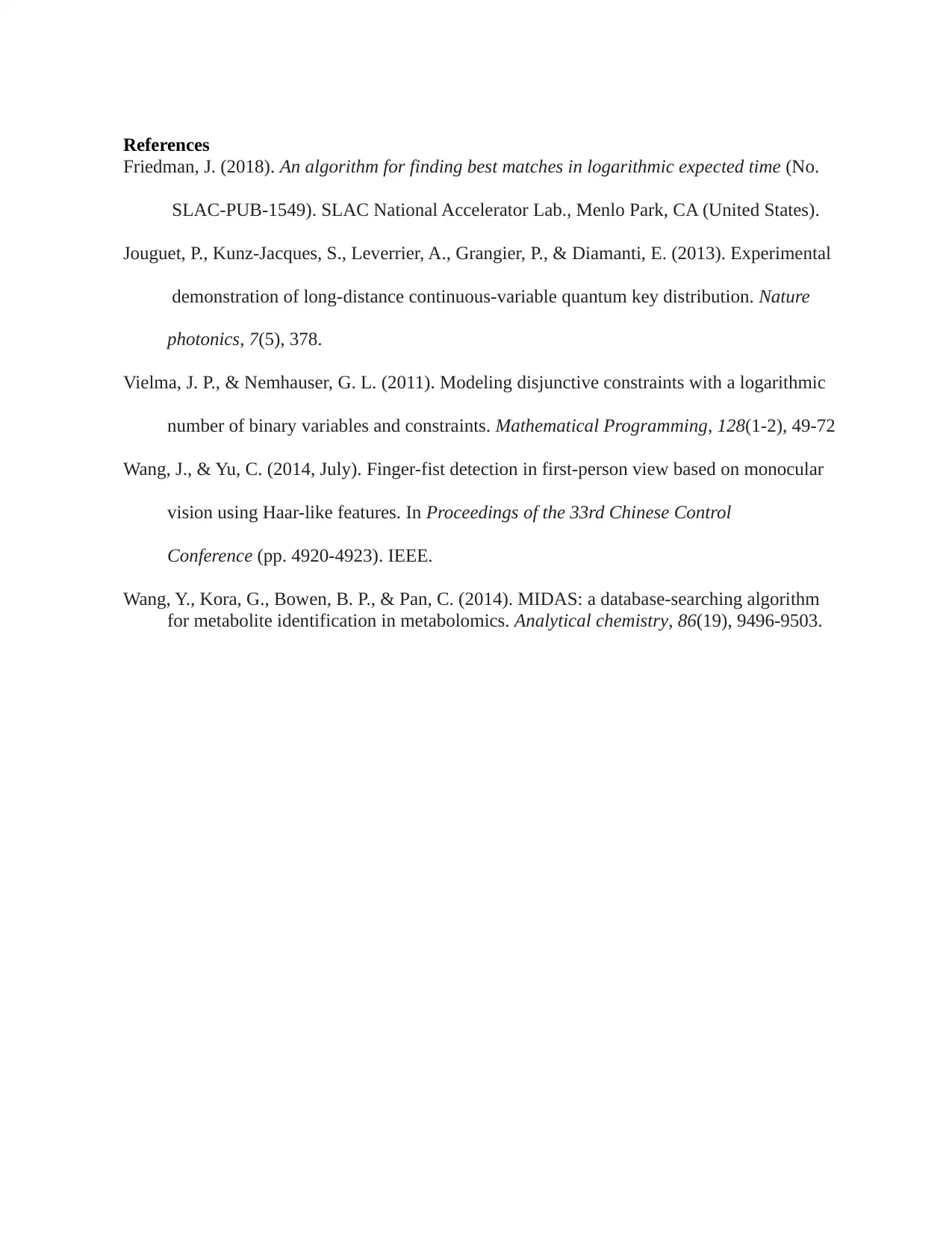
References
Friedman, J. (2018). An algorithm for finding best matches in logarithmic expected time (No.
SLAC-PUB-1549). SLAC National Accelerator Lab., Menlo Park, CA (United States).
Jouguet, P., Kunz-Jacques, S., Leverrier, A., Grangier, P., & Diamanti, E. (2013). Experimental
demonstration of long-distance continuous-variable quantum key distribution. Nature
photonics, 7(5), 378.
Vielma, J. P., & Nemhauser, G. L. (2011). Modeling disjunctive constraints with a logarithmic
number of binary variables and constraints. Mathematical Programming, 128(1-2), 49-72
Wang, J., & Yu, C. (2014, July). Finger-fist detection in first-person view based on monocular
vision using Haar-like features. In Proceedings of the 33rd Chinese Control
Conference (pp. 4920-4923). IEEE.
Wang, Y., Kora, G., Bowen, B. P., & Pan, C. (2014). MIDAS: a database-searching algorithm
for metabolite identification in metabolomics. Analytical chemistry, 86(19), 9496-9503.
Friedman, J. (2018). An algorithm for finding best matches in logarithmic expected time (No.
SLAC-PUB-1549). SLAC National Accelerator Lab., Menlo Park, CA (United States).
Jouguet, P., Kunz-Jacques, S., Leverrier, A., Grangier, P., & Diamanti, E. (2013). Experimental
demonstration of long-distance continuous-variable quantum key distribution. Nature
photonics, 7(5), 378.
Vielma, J. P., & Nemhauser, G. L. (2011). Modeling disjunctive constraints with a logarithmic
number of binary variables and constraints. Mathematical Programming, 128(1-2), 49-72
Wang, J., & Yu, C. (2014, July). Finger-fist detection in first-person view based on monocular
vision using Haar-like features. In Proceedings of the 33rd Chinese Control
Conference (pp. 4920-4923). IEEE.
Wang, Y., Kora, G., Bowen, B. P., & Pan, C. (2014). MIDAS: a database-searching algorithm
for metabolite identification in metabolomics. Analytical chemistry, 86(19), 9496-9503.
1 out of 10
Related Documents
Your All-in-One AI-Powered Toolkit for Academic Success.
+13062052269
info@desklib.com
Available 24*7 on WhatsApp / Email
![[object Object]](/_next/static/media/star-bottom.7253800d.svg)
Unlock your academic potential
Copyright © 2020–2025 A2Z Services. All Rights Reserved. Developed and managed by ZUCOL.





